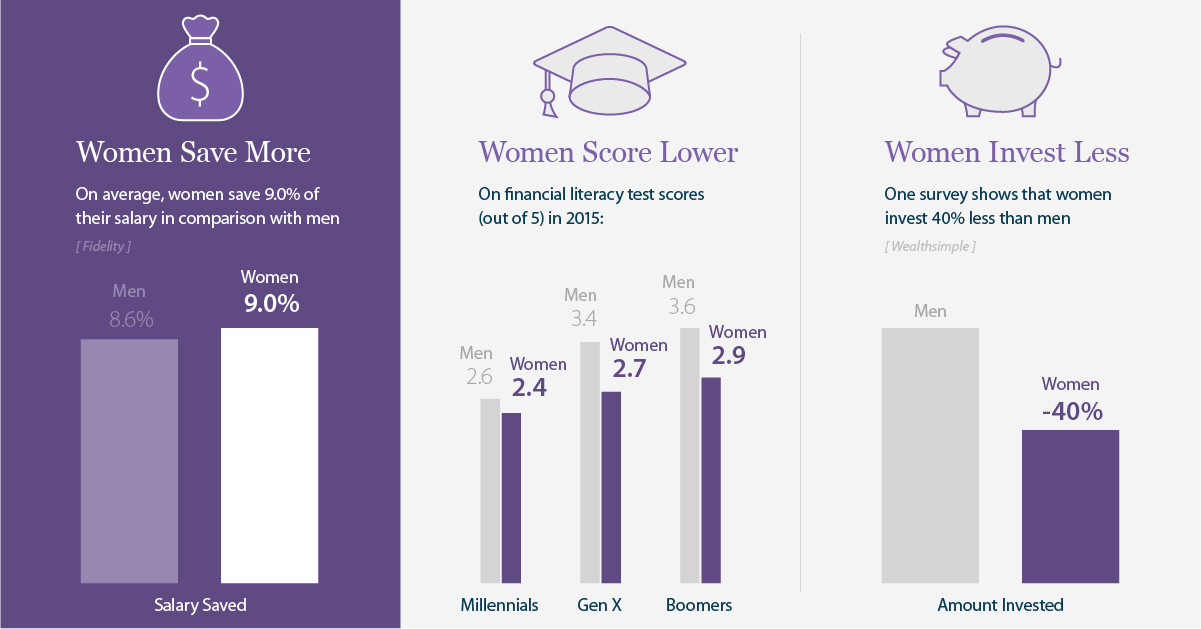Markets
Unlocking the Power of Women in Investing

Unlocking the Power of Women in Investing
The financial services industry is undergoing a dramatic shift.
The next generation of investors will be younger and much more diverse, with women taking an increasingly prominent role in building and growing family and personal wealth.
Today’s infographic comes to us from New York Life Investments, and it showcases how this new paradigm will shape the future of products and services on offer in the industry, as well as how wealth managers can cater to these changing needs.
Growing Economic Might
Women are underrepresented in the investing world, but this is changing fast. While various cultural and societal reasons are contributors to this, there is also a more simple driver: rising economic might.
- Women-controlled wealth in the U.S. will increase from $14 trillion to $22 trillion between 2015-2020
- Women control 51% of all personal wealth in the United States today
- Women are set to inherit $28.7 trillion in intergenerational wealth over the next 40 years
Women are becoming more important drivers of income and wealth for their families, as well:
- Women are now the primary breadwinners in 40% of U.S. households – a 4x increase from 1960.
- Women own 30% of all private businesses in the U.S.
- Women now hold the majority of management, professional, and related positions (52%)
Finally, women now make up the majority of recipients of Associate’s degrees (61%), Bachelor’s degrees (57%), Master’s degrees (60%), and Doctoral degrees (52%) in the United States.
The Wealth Management Gap
As women increase raise their level of economic influence to new levels, how will they manage this wealth?
Interestingly, studies show that women think about money and wealth differently than men – and differently from precedents already set in the financial services industry:
| The Good News | The Bad News |
|---|---|
| Women are better savers, saving 9.0% of their salary in comparison to men (8.6% of salary) | Women consistently tend to score lower on financial literacy tests |
| Some research points to women generating better returns (+0.4%) off of investments | Some research points to women investing up to 40% less than men |
Changing Concerns
Data from a recent survey by New York Life Investments sheds light on why women may be underserved by the financial services industry.
Reasons why women switch financial advisors:
- 33% poor performance
- 29% lack of personal connection
- 27% poor customer services
In other words, women don’t switch investment advisors simply because of poor performance – there are other, more complex factors involved. Part of this is likely because 62% of women say they have unique investment needs and challenges:
Perceptions of women and investing:
- Financial professionals treat women differently – 40%
- Women feel patronized by financial advisors – 36%
- Financial advisors are less likely to listen to investing ideas from a woman – 30%
- Financial advisors push women out of financial conversations – 28%
- Women have less access to financial education – 26%
- Financial professionals find it hard to relate to women – 26%
- Financial advising is a man’s world – 24%
A Deeper Dive
It is crucial for advisors to understand that women are not one large, homogeneous group.
In fact, research shows that there are four unique segments of women that each approach investing differently – and they all have different sets of needs.
Stay tuned for Part 2 of this infographic series, which will detail the differences between these segments.
Markets
The European Stock Market: Attractive Valuations Offer Opportunities
On average, the European stock market has valuations that are nearly 50% lower than U.S. valuations. But how can you access the market?

European Stock Market: Attractive Valuations Offer Opportunities
Europe is known for some established brands, from L’Oréal to Louis Vuitton. However, the European stock market offers additional opportunities that may be lesser known.
The above infographic, sponsored by STOXX, outlines why investors may want to consider European stocks.
Attractive Valuations
Compared to most North American and Asian markets, European stocks offer lower or comparable valuations.
| Index | Price-to-Earnings Ratio | Price-to-Book Ratio |
|---|---|---|
| EURO STOXX 50 | 14.9 | 2.2 |
| STOXX Europe 600 | 14.4 | 2 |
| U.S. | 25.9 | 4.7 |
| Canada | 16.1 | 1.8 |
| Japan | 15.4 | 1.6 |
| Asia Pacific ex. China | 17.1 | 1.8 |
Data as of February 29, 2024. See graphic for full index names. Ratios based on trailing 12 month financials. The price to earnings ratio excludes companies with negative earnings.
On average, European valuations are nearly 50% lower than U.S. valuations, potentially offering an affordable entry point for investors.
Research also shows that lower price ratios have historically led to higher long-term returns.
Market Movements Not Closely Connected
Over the last decade, the European stock market had low-to-moderate correlation with North American and Asian equities.
The below chart shows correlations from February 2014 to February 2024. A value closer to zero indicates low correlation, while a value of one would indicate that two regions are moving in perfect unison.
| EURO STOXX 50 | STOXX EUROPE 600 | U.S. | Canada | Japan | Asia Pacific ex. China |
|
|---|---|---|---|---|---|---|
| EURO STOXX 50 | 1.00 | 0.97 | 0.55 | 0.67 | 0.24 | 0.43 |
| STOXX EUROPE 600 | 1.00 | 0.56 | 0.71 | 0.28 | 0.48 | |
| U.S. | 1.00 | 0.73 | 0.12 | 0.25 | ||
| Canada | 1.00 | 0.22 | 0.40 | |||
| Japan | 1.00 | 0.88 | ||||
| Asia Pacific ex. China | 1.00 |
Data is based on daily USD returns.
European equities had relatively independent market movements from North American and Asian markets. One contributing factor could be the differing sector weights in each market. For instance, technology makes up a quarter of the U.S. market, but health care and industrials dominate the broader European market.
Ultimately, European equities can enhance portfolio diversification and have the potential to mitigate risk for investors.
Tracking the Market
For investors interested in European equities, STOXX offers a variety of flagship indices:
| Index | Description | Market Cap |
|---|---|---|
| STOXX Europe 600 | Pan-regional, broad market | €10.5T |
| STOXX Developed Europe | Pan-regional, broad-market | €9.9T |
| STOXX Europe 600 ESG-X | Pan-regional, broad market, sustainability focus | €9.7T |
| STOXX Europe 50 | Pan-regional, blue-chip | €5.1T |
| EURO STOXX 50 | Eurozone, blue-chip | €3.5T |
Data is as of February 29, 2024. Market cap is free float, which represents the shares that are readily available for public trading on stock exchanges.
The EURO STOXX 50 tracks the Eurozone’s biggest and most traded companies. It also underlies one of the world’s largest ranges of ETFs and mutual funds. As of November 2023, there were €27.3 billion in ETFs and €23.5B in mutual fund assets under management tracking the index.
“For the past 25 years, the EURO STOXX 50 has served as an accurate, reliable and tradable representation of the Eurozone equity market.”
— Axel Lomholt, General Manager at STOXX
Partnering with STOXX to Track the European Stock Market
Are you interested in European equities? STOXX can be a valuable partner:
- Comprehensive, liquid and investable ecosystem
- European heritage, global reach
- Highly sophisticated customization capabilities
- Open architecture approach to using data
- Close partnerships with clients
- Part of ISS STOXX and Deutsche Börse Group
With a full suite of indices, STOXX can help you benchmark against the European stock market.

Learn how STOXX’s European indices offer liquid and effective market access.

-

 Economy1 day ago
Economy1 day agoEconomic Growth Forecasts for G7 and BRICS Countries in 2024
The IMF has released its economic growth forecasts for 2024. How do the G7 and BRICS countries compare?
-

 Markets1 week ago
Markets1 week agoU.S. Debt Interest Payments Reach $1 Trillion
U.S. debt interest payments have surged past the $1 trillion dollar mark, amid high interest rates and an ever-expanding debt burden.
-

 United States1 week ago
United States1 week agoRanked: The Largest U.S. Corporations by Number of Employees
We visualized the top U.S. companies by employees, revealing the massive scale of retailers like Walmart, Target, and Home Depot.
-

 Markets2 weeks ago
Markets2 weeks agoThe Top 10 States by Real GDP Growth in 2023
This graphic shows the states with the highest real GDP growth rate in 2023, largely propelled by the oil and gas boom.
-

 Markets2 weeks ago
Markets2 weeks agoRanked: The World’s Top Flight Routes, by Revenue
In this graphic, we show the highest earning flight routes globally as air travel continued to rebound in 2023.
-

 Markets2 weeks ago
Markets2 weeks agoRanked: The Most Valuable Housing Markets in America
The U.S. residential real estate market is worth a staggering $47.5 trillion. Here are the most valuable housing markets in the country.
-

 Mining1 week ago
Mining1 week agoGold vs. S&P 500: Which Has Grown More Over Five Years?
-

 Markets2 weeks ago
Markets2 weeks agoRanked: The Most Valuable Housing Markets in America
-

 Money2 weeks ago
Money2 weeks agoWhich States Have the Highest Minimum Wage in America?
-

 AI2 weeks ago
AI2 weeks agoRanked: Semiconductor Companies by Industry Revenue Share
-

 Markets2 weeks ago
Markets2 weeks agoRanked: The World’s Top Flight Routes, by Revenue
-

 Demographics2 weeks ago
Demographics2 weeks agoPopulation Projections: The World’s 6 Largest Countries in 2075
-

 Markets2 weeks ago
Markets2 weeks agoThe Top 10 States by Real GDP Growth in 2023
-

 Demographics2 weeks ago
Demographics2 weeks agoThe Smallest Gender Wage Gaps in OECD Countries












